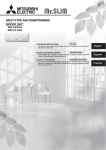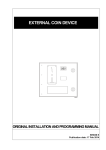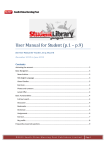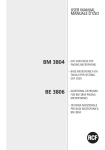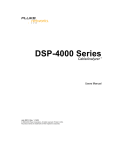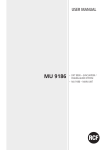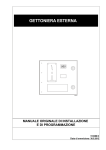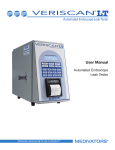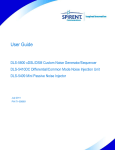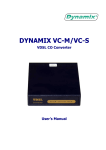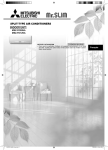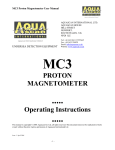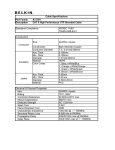Download LANcat - Electrocomponents
Transcript
LANcat™ System 6 with C5e Performance Module User Manual Addendum Datacom Textron may make improvements or additions to this publication or their products at any time without notice. Datacom Textron shall not be liable for technical or editorial errors or omissions contained herein. LANcat is a registered trademark of Datacom Textron. P/N 13789 Rev. B © Copyright 1998 by Datacom Textron 11001 31st Place West Everett, WA 98204 Telephone 425-355-0590 800-468-5557 Fax 425-290-1600 www.datacom.textron.com Contents Contents LANcat System 6 Introduction 3 Enhanced Test Specifications....................................... 4 Test Reports ................................................................ 5 Performance Module Installation 6 Autotests 8 Running Autotest ........................................................ 10 Viewing 250 MHz Autotest Results ........................... 11 Viewing Test Results ................................................ 11 Link Performance Screen .......................................... 12 Power Sum ACR ....................................................... 13 Return Loss ............................................................... 14 Viewing Return Loss Results .................................... 14 ELFEXT.................................................................... 16 Viewing Power Sum ELFEXT Results ..................... 18 Certifying Category 5 Cabling 20 Pair-to-Pair NEXT Method ....................................... 20 Power Sum NEXT Method ....................................... 21 Page 1 LANcat System 6 User Manual Link Performance Analysis Beyond 100 MHz – ACR and Headroom 23 Test Reports 24 Performance Module Cable Replacement 28 Warranty 31 User-Guard™ Support Program............................... 31 Two Year Product Warranty ..................................... 32 Page 2 Introduction LANcat System 6 Introduction LANcat System 6 consists of a pair of LANcat testers equipped with 250 MHz C5e Performance Modules. The C5e Performance Modules take Category 5 testing beyond current Category 5 standards of 100 MHz, providing critical information for Enhanced Category 5 and Gigabit cabling. System 6 offers an unequalled combination of power, measurement precision, ease of use, and low ownership cost. This unique modular design makes LANcat the most versatile tester on the market. In addition to being fully compliant with TIA TSB 67 requirements for certifying CAT 5/Class D links, the LANcat System 6 performs several important new measurements including Power Sum Near End Crosstalk (PS-NEXT) and Power Sum Attenuation-to-Crosstalk Ratio (PS-ACR) to 250 MHz. Modules provide Equal Level Far End Crosstalk (ELFEXT), PS ELFEXT, and Return Loss testing as required in the proposed Enhanced Category 5 standard, to 100 MHz. Padded protective overcases supplied with the system enclose both the tester and performance module, providing protection from damage in the field while allowing full access to the display and all controls. The LANcat System 6 with C5e Performance Modules fully complies with the proposed TIA Level IIe accuracy specifications. Page 3 LANcat System 6 User Manual This manual only describes features and operation specific to LANcat Handsets equipped with C5e Performance Modules. Please refer to the LANcat Series Cable Testers User Manual for general operation, maintenance, and specifications. Enhanced Test Specifications The following 100 MHz Certification Standards can be extended to 250 MHz for verification purposes. • TSB-67 CAT 3, 4, 5 • TIA Category 5e • TSB-95 • ISO 11801 Class C, D • EN50173 Class D • ScTP Class C, D • AS/NZS 3080 Class C, D • BICC Millennium • FTP 120 Ohms • JIS X 5150 Page 4 Introduction A TwoWay system (two LANcat System 6 testers) is required for 250 MHz tests and all Remote NEXT, ELFEXT, and Return Loss tests. Firmware versions below 6.00 require factory calibration before running 250 MHz tests. Contact Datacom Textron for factory calibration details. Cable Grading is not available for firmware versions 6.00 D3/D4 or higher. Cable grading has been superceded by headroom and link performance analysis detail screens. The following 100 MHz Network Standards can be extended to 250 MHz for verification purposes. • IEEE 100BASE-Tx • ANSI X3T9.5 TP-PMD • ATM 155 MBPS Test Reports Each LANcat tester can store up to 400 test reports (800 total per system). Test reports can be saved in 3 different formats: • • • Encrypted tamper proof Report Manager format. Comma Separated Variable for import into spreadsheet programs. Text files for import into word processing programs. Page 5 LANcat System 6 User Manual Performance Module Installation Make sure the unit is turned off before attempting module installation or removal. To install the C5e Performance Module, slide it into the opening on the LANcat until the screws rest against the retainers, then evenly hand-tighten the screws until the module is properly seated (refer to Figure 1-1). To remove a module, loosen the thumbscrews at either side of the module until the screws are free of the retainers. Hold the module on either side and slide it out of the opening. CAUTION To avoid damage to the LANcat, tighten the screws evenly using finger pressure only. Make sure to turn both screws either simultaneously or alternately in small increments. The module is designed to be installed or removed without tools. Page 6 Performance Module Installation STATIC AWARENESS The LANcat contains static sensitive electronics inside the main body. Use appropriate precautions when removing and installing performance modules. Figure 1-1. Module Installation Page 7 LANcat System 6 User Manual Autotests Autotest is a preprogrammed suite of tests that are required to certify a cabling link. The following tests are required by TIA/EIA: • • • • • • Wire Map Near-End Crosstalk (NEXT) Attenuation Length Return Loss (CAT5e) ELFEXT (CAT5e) The following tests may be added to the Autotest suite of tests by defining a Custom Cable standard (see the LANcat User Manual, Appendix A, Defining Custom Standards): • • • • • • • • • • Page 8 Delay / Delay Skew 250 MHz UTP (100 MHz standards only) Power Sum Link Performance Power Sum NEXT Power Sum ACR Resistance ACR Return Loss ELFEXT Power Sum ELFEXT Autotests Please note that impedance is not tested when using the C5e Performance Module. The maximum cable length measured by the System 6 is 1100 feet. NOTES ON 250 MHZ TESTING • 250 MHz testing is available for all 100 MHz tests. This option is available by entering the CHANGE CABLE STANDARD menu and editing the selected test standard. Using this option, the instrument will extend NEXT and ATTENUATION measurements out to 250 MHz. • PASS or FAIL indications when running Autotest are based on existing 100 MHz test standards. • 250 MHz tests can also be enabled by selecting “250 MHz UTP” in the Cable Standard menu. • If the LANcat fails any test, it will stop and display the failure. You may continue testing by pressing the CONTINUE (F4) softkey. Page 9 LANcat System 6 User Manual Running Autotest 1. 2. 3. 4. Connect each tester to the cable under test. Set one tester dial to REMOTE. Set the other tester dial to AUTOTEST. Use the up/down arrow keys to enter the CHANGE CABLE STANDARD menu. 5. Use the up/down arrow keys to highlight the desired Cable Standard. Press SELECT (F4) to update both testers to the chosen standard. The test will run automatically. 6. After completing an Autotest, press START (Fl) to re-start Autotest. Press VIEW (F3) to review the test results. Press SAVE (F4) or ENTER to save the test results. Page 10 Autotests Viewing 250 MHz Autotest Results After performing an Autotest, LANcat will display PASS, FAIL or PASS*, FAIL*. LANcat also displays Headroom and Crossover. Headroom (expressed in Decibels or dB) is based on the worst case measurement of Power Sum NEXT relative to the NEXT standard for the cable test chosen. Crossover value (in MHz) is the frequency at which Power Sum ACR equals zero (PSNEXT-Attenuation = PSACR) Two new System 6 test summary screens are shown after an Autotest: Link Performance and Power Sum ACR. Viewing Test Results 1. After completing Autotest, press VIEW (F3) from the Autotest results screen. 2. Press the arrow keys to view additional summary test result screens (Link Performance and PSACR are shown after the NEXT results). 3. Press SAVE (F4) or ENTER at any time to save the Autotest results. 4. Press GRAPH (F2) to view a graphic display of the test results. 5. Press SEND (F1) to send the results to the Remote Unit. 6. Press ESC to exit View. Page 11 LANcat System 6 User Manual Link Performance Screen The Link Performance screen provides additional cable performance information. This screen displays Headroom (HR) and the Power Sum Attenuation to Crosstalk Ratio (PS-ACR) for all four wire pairs. Headroom Headroom (HR) is displayed in Decibels (dB) and indicates the measured difference between actual cable performance and current Category 5 standards. A high dB value for Headroom indicates a level of performance greater than Cat 5. Page 12 Autotests Power Sum ACR Power Sum Attenuation to Crosstalk Ratio (PS-ACR) is displayed two ways. The column ACR=10 dB indicates the frequency at which the pair tested had an ACR value of 10 dB. This is generally accepted to be the useable bandwidth of the cable while still having enough signal strength to guarantee low data transmission error rates. The column ACR=0 dB indicates the frequency at which ACR measured zero. This zero point is considered the absolute maximum useable bandwidth of the cable. Page 13 LANcat System 6 User Manual Return Loss Return Loss is a measure of the reflected energy caused by impedance mismatches in the cabling system. Return Loss is expressed as the ratio, in dB, of the incident power and reflected power. Since it is desirable to have the least amount of energy reflected, larger values are desirable. Return Loss is especially important for applications such as Gigabit Ethernet that use simultaneous bi-directional transmission. Return Loss measurements are made to 100 MHz as required in the proposed Enhanced Category 5 specification. Viewing Return Loss Results Test Specification Press GRAPH (F2) to view a graph of Return Loss results. Page 14 Autotests Test Limit Cursor Test Results Return Loss Reporting Return Loss measurements for Enhanced Category 5 are being added to TIA/EIA 568-A via Standards Proposal 4195-A. When this proposal is adopted, standard 568-A will be amended as 568-A-5. At this point in time, the committee developing Proposal 4195 is still debating the standards for devices measuring return loss and the return loss limits for installed cabling. Since actual requirements are still under debate, return loss is reported for informational value only. Standards that require return loss measurements will not be failed based on return loss measurements. Page 15 LANcat System 6 User Manual ELFEXT Equal Level Far End Crosstalk or ELFEXT is derived from Far End Crosstalk (FEXT) measurements and attenuation measurements. FEXT is a measure of the unwanted signal from a transmitter at the near-end into a neighboring pair at the far-end. ELFEXT is expressed in dB as the difference between the measured FEXT and the attenuation of the disturbed pair. Power Sum ELFEXT takes into account the combined crosstalk on a receive pair from all the far end disturbers operating simultaneously. ELFEXT measurements are made to 100 MHz as required in the proposed Enhanced Category 5 specification. Viewing ELFEXT Results Test Summary Press DETAIL (F3) to view ELFEXT test specifications. Page 16 Autotests Test Specification Press GRAPH (F2) to view a graph of ELFEXT Results Test Limit Cursor Test Results Page 17 LANcat System 6 User Manual Viewing Power Sum ELFEXT Results Test Summary Press SPEC (F3) to view PS ELFEXT test specifications. Test Specification Press GRAPH (F2) to view a graph of PS ELFEXT Results. Page 18 Autotests Test Limit Cursor Test Results Page 19 LANcat System 6 User Manual Certifying Category 5 Cabling Pair-to-Pair NEXT Method NEXT, as defined in TIA TSB-67, is a measure of signal coupling from one pair to another pair within the fourpair cable. It is also sometimes called pair-to-pair NEXT. TSB-67 requires that pair-to-pair NEXT be measured on all six pair combinations, and that the worst pair-to-pair NEXT measurement not exceed specified test limits for the Basic Link or Channel test configurations. The pair-to-pair NEXT measurements, however, only account for crosstalk coupled from any one pair to another - not the possible total crosstalk that might be coupled from multiple pairs in the same sheath. The TSB-67 methodology assumes that only two pairs of the cable would be used at any given time for data transmission. While pair-to-pair NEXT is an appropriate crosstalk measure for 2-pair network schemes, such as 10BASE-T and 100BASE-Tx, it does not provide an adequate measure of cable performance when multiple pairs within the same sheath may be transmitting simultaneously, such as in Gigabit Ethernet. Page 20 Certifying Category 5 Cabling Power Sum NEXT Method Power Sum NEXT (PS-NEXT) is the sum of the NEXT power coupled to a wire pair from all other adjacent pairs. Power Sum is specified by TIA 568A as the recommended method for characterizing NEXT of multipair backbone cable. PS-NEXT can be computed from the individual pair-to-pair NEXT measurements. The graph below shows the computed PS-NEXT for a typical CAT 5 link, compared to a composite curve representing the greatest (i.e. closest to the TSB-67 NEXT limit) pair-to-pair NEXT values for the same link. As seen from this example, the PS-NEXT values are always worse than the greatest pair-to-pair NEXT values. In fact, PS-NEXT for four-pair cabling can be as much as 4.77 dB worse than the greatest pair-to-pair NEXT measurement. A link that easily passes TSB-67 Category 5 pair-to-pair NEXT requirements might therefore fail if PS-NEXT is used as the measure. Page 21 LANcat System 6 User Manual Several manufacturers of enhanced-performance CAT 5 cables and connectors specify PS-NEXT as a measure of product performance. Because PS-NEXT is a more stringent NEXT characterization method, components that are specified and tested to meet Power Sum are more likely to deliver optimum performance, even beyond TIA 568A defined CAT 5 requirements. Page 22 Link Performance Analysis Link Performance Analysis Beyond 100 MHz – ACR and Headroom Power Sum ACR measurements beyond 100 MHz are valuable for determining adequate performance of enhanced Cat 5 cabling. Current Cat 5 standards require a minimum of 10 dB ACR at 100 MHz. Proposed Cat 6 standards recommend an ACR value of a minimum 10 dB ACR at 200 MHz. System 6 provides this measure of cable performance up to 250 MHz. The frequency at which the cable had a measured 10 dB ACR value is clearly displayed in the LINK PERFORMANCE screen. The following graph illustrates the ACR vs. Frequency relationship: Measured Cable Attenuation Headroom Attenuation Spec dB Next Spec Measured Cable NEXT Cable Test Frequency (MHz) 100 ACR Crossover Point 250 Page 23 LANcat System 6 User Manual Test Reports Up to 400 test reports can be saved in each LANcat System 6 tester. Reports can be uploaded to a PC and viewed or printed with the Report Manager software. Please refer to Chapter 6 in the LANcat Series Cable Testers User Manual for more information on working with reports. Page 24 Test Reports Sample 250 MHz UTP Autotest Report LANcat CABLE CERTIFICATION REPORT # Circuit ID: Cable Test Standard: CAT5EN Basic Link Location: ___________________________ Date Tested: 11/04/1998 1 Local Module Type: C5e Modular Plug Remote Module Type: C5e Modular Plug Serial Number: 1111111 V9.99D4 Cable NVP: 72.0% TEST SUMMARY: PASS _______________________________________________________________________________ Wire Map: PASS Near End 1 2 3 6 4 5 7 8 Shield | | | | | | | | open Remote End 1 2 3 6 4 5 7 8 _______________________________________________________________________________ Length: PASS Limit: 308ft Pair Length Delay Skew Comments 1,2 8ft 1ns OPEN 3,6 8ft 0ns OPEN 4,5 8ft 0ns OPEN 7,8 9ft 2ns OPEN ______________________________________________________________________________ Attenuation: PASS 1,2 3,6 4,5 7,8 PASS PASS PASS PASS Attenuation dB 1.1 1.0 1.0 0.9 Limit dB 21.7 21.7 21.5 21.7 Margin dB +20.6 +20.7 +20.5 +20.8 Frequency MHz 101.0 101.0 99.0 101.0 ______________________________________________________________________________ PSNEXT: PASS 1,2 3,6 4,5 7,8 PASS PASS PASS PASS Power Sum dB 41.0 39.0 39.6 42.0 Limit dB 33.3 32.5 32.3 35.9 Margin dB +7.7 +6.5 +7.3 +6.1 Frequency MHz 86.8 97.6 100.1 60.5 Remote PSNEXT: PASS 1,2 3,6 4,5 7,8 PASS PASS PASS PASS Power Sum dB 41.1 41.3 39.9 41.8 Limit dB 33.3 35.0 32.3 35.9 Margin dB +7.8 +6.3 +7.6 +5.9 Frequency MHz 87.0 68.6 100.1 60.5 ______________________________________________________________________________ Return Loss: 1,2 3,6 4,5 7,8 Return Loss dB 19.9 15.5 21.0 15.4 Limit dB 17.0 12.5 17.0 12.9 Margin dB +2.9 +3.0 +4.0 +2.5 Frequency MHz 0.9 87.3 0.9 76.9 Rem Return Loss: Return Loss dB Limit dB Margin dB Frequency MHz 1,2 19.8 17.0 +2.8 0.9 3,6 15.6 12.5 +3.1 86.6 4,5 19.9 17.0 +2.9 0.9 7,8 15.4 12.7 +2.7 81.2 Page 25 LANcat System 6 User Manual Sample C5e Autotest Report LANcat CABLE CERTIFICATION REPORT # Circuit ID: Cable Test Standard: CAT5e Basic Link Location: ___________________________ Date Tested: 12/10/1998 1 Local Module Type: C5e Modular Plug Remote Module Type: C5e Modular Plug Serial Number: 0000000 V9.99D4 Cable NVP: 72.0% TEST SUMMARY: PASS _______________________________________________________________________________ Wire Map: PASS Near End 1 2 3 6 4 5 7 8 Shield | | | | | | | | open Remote End 1 2 3 6 4 5 7 8 _______________________________________________________________________________ Length: PASS Limit: 308ft Pair Length Delay Skew Comments 1,2 8ft 1ns OPEN 3,6 7ft 0ns OPEN 4,5 8ft 0ns OPEN 7,8 9ft 2ns OPEN _______________________________________________________________________________ Attenuation: PASS 1,2 3,6 4,5 7,8 PASS PASS PASS PASS Attenuation dB 0.9 0.9 0.9 0.9 Limit dB 21.7 21.7 21.7 21.7 Margin dB +20.8 +20.8 +20.8 +20.8 Frequency MHz 101.0 101.0 101.0 101.0 _______________________________________________________________________________ PSNEXT: PASS 1,2 3,6 4,5 7,8 PASS PASS PASS PASS Power Sum dB 49.5 39.1 39.0 43.4 Limit dB 41.1 32.4 32.3 35.7 Margin dB +8.4 +6.7 +6.7 +7.7 Frequency MHz 28.9 99.0 100.1 62.1 Remote PSNEXT: PASS 1,2 3,6 4,5 7,8 PASS PASS PASS PASS Power Sum dB 40.7 38.8 39.3 43.4 Limit dB 33.2 32.7 32.3 35.7 Margin dB +7.5 +6.1 +7.0 +7.7 Frequency MHz 88.4 94.9 100.1 62.3 _______________________________________________________________________________ Return Loss: 1,2 3,6 4,5 7,8 Return Loss dB 16.3 14.8 21.0 15.3 Limit dB 13.0 12.6 17.0 12.7 Margin dB +3.3 +2.2 +4.0 +2.6 Frequency MHz 73.5 83.9 0.9 82.1 Rem Return Loss: 1,2 3,6 4,5 7,8 Return Loss dB 16.4 14.3 21.8 16.4 Limit dB 12.9 12.5 17.0 12.9 Margin dB +3.5 +1.8 +4.8 +3.5 Frequency MHz 76.0 87.7 0.9 76.0 ______________________________________________________________________________ ELFEXT: PASS 12/36 12/45 12/78 36/45 36/78 45/78 PASS PASS PASS PASS PASS PASS ELFEXT dB 63.1 69.5 85.6 53.0 80.8 83.0 Limit dB 44.3 46.0 63.1 28.0 63.1 63.1 Margin dB +18.8 +23.5 +22.5 +25.0 +17.7 +19.9 Frequency MHz 8.1 6.6 0.9 53.1 0.9 0.9 ELFEXT Page 26 dB 36/12 PASS 63.4 45/12 PASS 68.8 78/12 PASS 85.5 45/36 PASS 50.9 78/36 PASS 81.1 78/45 PASS 82.3 Test Reports Limit Margin Frequency dB dB MHz Remote ELFEXT: PASS ELFEXT Limit Margin Frequency dB dB dB MHz 44.3 +19.1 8.1 46.0 +22.8 7.2 63.1 +22.4 0.9 28.0 +22.9 69.9 63.1 +18.0 0.9 63.1 +19.2 0.9 12/36 PASS 63.1 44.3 +18.8 8.1 12/45 PASS 69.5 46.0 +23.5 6.6 12/78 PASS 85.6 63.1 +22.5 0.9 36/45 PASS 53.0 28.0 +25.0 53.1 36/78 PASS 80.8 63.1 +17.7 0.9 45/78 PASS 83.0 63.1 +19.9 0.9 36/12 45/12 78/12 45/36 78/36 78/45 PASS PASS PASS PASS PASS PASS ELFEXT dB 63.4 68.8 85.5 50.9 81.1 82.3 Limit dB 44.3 46.0 63.1 28.0 63.1 63.1 Margin dB +19.1 +22.8 +22.4 +22.9 +18.0 +19.2 Frequency MHz 8.1 7.2 0.9 69.9 0.9 0.9 ______________________________________________________________________________ PSELFEXT: PASS 1,2 3,6 4,5 7,8 PASS PASS PASS PASS Power Sum dB 70.6 69.4 72.5 69.4 Limit dB 60.4 60.4 60.4 60.4 Margin dB +10.2 +9.0 +12.1 +9.0 Frequency MHz 1.2 1.2 1.2 1.2 REM PSELFEXT: PASS 1,2 3,6 4,5 7,8 PASS PASS PASS PASS Power Sum dB 70.6 69.4 72.5 69.4 Limit dB 60.4 60.4 60.4 60.4 Margin dB +10.2 +9.0 +12.1 +9.0 Frequency MHz 1.2 1.2 1.2 1.2 ______________________________________________________________________________ Operator: Comments: _______________________ Date: ____________________ END REPORT #1 Page 27 LANcat System 6 User Manual Performance Module Cable Replacement The performance module test cable can be field replaced should the part become worn or damaged. Steps: 1. Remove module from main unit (unit off). 2. Remove Philips screws holding module halves together. 3. Slide top cover of module off lower portion. 4. Cut zip tie (2). Page 28 Performance Module Cable Replacement 5. Loosen the screws on the cable terminal blocks and remove the wires. 6. Remove the black grommet (1) from the old cable. 7. Remove the module cover from the old cable. 8. Install the module cover onto the new cable. 9. Install the grommet onto the new cable and position it as shown (1). 10. Insert the stripped wire ends (4) of the replacement cable into the terminal blocks. Make sure to note the proper position and color codes of the wires. Note: The factory cable is wired as per T568B. It is possible to use a T568A test cable if the module is wired accordingly. To wire the module to T568A, swap the positions of the orange/orange-white and green/greenwhite wire pairs. Tighten the terminal block screws. 11. Position the grommet as shown and fasten into place using new zip tie (2). Make sure the grommet is positioned as shown (3). 12. Slide the module cover back into place and fasten using screws provided. Do not overtighten. 13. Insert module back into main unit. It is recommended that a Performance Module calibration be performed after replacing the cable. Page 29 LANcat System 6 User Manual NOTE: To achieve optimum performance, advanced cabling systems manufacturer’s recommend the use of their products for the complete end-to-end system. Accordingly, maximum test accuracy can only be achieved by using a System 6 patch cable that is of the same type as the cabling being tested. Technical Support Datacom Textron offers unlimited free technical support for LANcat customers. If you have questions or comments, contact your sales representative or distributor, or call Datacom Textron and ask for technical support. Hours are Monday through Friday, 8 AM to 5:00 PM Pacific Time. US and Canada 800-468-5557 425-355-0590 International 425-355-0590 Fax 425-290-1600 Web Site www.datacom.textron.com Page 30 Warranty Warranty User-Guard™ Support Program Datacom Textron provides the following services and benefits to LANcat System 6 owners. Calibration Services - Annual re-calibration services by a Datacom Textron certified service center for two years (United States only). Priority Cross-Shipments - If a Datacom Textron product ever requires factory service or repair, Datacom Textron offers next-day exchange or loan of a replacement unit (United States only). Technical Support Hotlines - Unlimited access to Datacom Textron's staff of knowledgeable Application Engineers for questions on product usage and applications. Contact may be made a toll-free service line, dedicated email support line, or the Datacom Textron Web site. Training - A variety of self-training instructional materials are available to assist users in the proper use and application of Datacom Textron instruments. These include technical notes, application notes, quickreference guides, and tutorial handbooks. These materials may be ordered from the Datacom Textron Web site. Product Updates/Upgrades - Product firmware upgrades are made available at no extra charge from the Datacom Textron Web site at www.datacom.textron.com. Page 31 LANcat System 6 User Manual Two Year Product Warranty The LANcat System 6 is warranted against defects in materials and workmanship within a period of two (2) years following the date of purchase of the tester. Any instrument claimed to be defective during the warranty period should be returned to Datacom Textron’s Factory Service Center. Refer to the chapter on Technical Support and Service for further instructions. ANY IMPLIED WARRANTIES ARISING OUT OF THE SALE OF A LANCAT SYSTEM 6 CABLE TESTER, INCLUDING BUT NOT LIMITED TO IMPLIED WARRANTIES OF MERCHANTABILITY AND FITNESS FOR A PARTICULAR PURPOSE, ARE LIMITED IN DURATION TO THE ABOVE STATED TWO (2) YEAR PERIOD. DATACOM TEXTRON SHALL NOT BE LIABLE FOR LOSS OF USE OF THE TESTER OR OTHER INCIDENTAL OR CONSEQUENTIAL DAMAGES, EXPENSES OR ECONOMIC LOSS. Some states and countries do not allow limitations on how long implied warranties last or the exclusions or limitation of incidental or consequential damages, so the above limitations or exclusions may not apply to you. This warranty gives you specific legal rights, and you may also have other rights which vary from state to state. Datacom Textron certifies that this instrument was thoroughly tested and found to meet its published specifications when shipped from the factory. Page 32


































